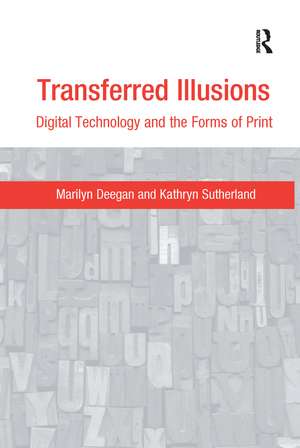Transferred Illusions: Digital Technology and the Forms of Print: Digital Research in the Arts and Humanities
Autor Marilyn Deegan, Kathryn Sutherlanden Limba Engleză Paperback – 11 noi 2016
Din seria Digital Research in the Arts and Humanities
-
 Preț: 311.33 lei
Preț: 311.33 lei -
 Preț: 312.09 lei
Preț: 312.09 lei - 20%
 Preț: 946.37 lei
Preț: 946.37 lei -
 Preț: 324.93 lei
Preț: 324.93 lei - 9%
 Preț: 935.99 lei
Preț: 935.99 lei - 20%
 Preț: 247.23 lei
Preț: 247.23 lei -
 Preț: 311.28 lei
Preț: 311.28 lei -
 Preț: 281.45 lei
Preț: 281.45 lei -
 Preț: 325.94 lei
Preț: 325.94 lei - 31%
 Preț: 766.31 lei
Preț: 766.31 lei - 18%
 Preț: 1000.27 lei
Preț: 1000.27 lei - 16%
 Preț: 335.37 lei
Preț: 335.37 lei -
 Preț: 460.69 lei
Preț: 460.69 lei - 18%
 Preț: 1003.64 lei
Preț: 1003.64 lei - 22%
 Preț: 324.16 lei
Preț: 324.16 lei - 31%
 Preț: 764.20 lei
Preț: 764.20 lei -
 Preț: 401.14 lei
Preț: 401.14 lei - 20%
 Preț: 1053.91 lei
Preț: 1053.91 lei -
 Preț: 389.38 lei
Preț: 389.38 lei - 28%
 Preț: 819.90 lei
Preț: 819.90 lei -
 Preț: 417.03 lei
Preț: 417.03 lei - 16%
 Preț: 339.10 lei
Preț: 339.10 lei -
 Preț: 389.38 lei
Preț: 389.38 lei -
 Preț: 383.24 lei
Preț: 383.24 lei - 16%
 Preț: 337.84 lei
Preț: 337.84 lei - 16%
 Preț: 311.31 lei
Preț: 311.31 lei -
 Preț: 489.26 lei
Preț: 489.26 lei -
 Preț: 469.34 lei
Preț: 469.34 lei - 18%
 Preț: 1004.55 lei
Preț: 1004.55 lei - 18%
 Preț: 1005.67 lei
Preț: 1005.67 lei - 18%
 Preț: 999.46 lei
Preț: 999.46 lei - 18%
 Preț: 1000.27 lei
Preț: 1000.27 lei -
 Preț: 489.26 lei
Preț: 489.26 lei - 18%
 Preț: 1000.27 lei
Preț: 1000.27 lei - 18%
 Preț: 1058.65 lei
Preț: 1058.65 lei - 18%
 Preț: 1000.27 lei
Preț: 1000.27 lei - 13%
 Preț: 338.33 lei
Preț: 338.33 lei - 30%
 Preț: 878.82 lei
Preț: 878.82 lei - 26%
 Preț: 764.20 lei
Preț: 764.20 lei
Preț: 338.33 lei
Preț vechi: 386.77 lei
-13% Nou
Puncte Express: 507
Preț estimativ în valută:
64.74€ • 67.59$ • 53.58£
64.74€ • 67.59$ • 53.58£
Carte tipărită la comandă
Livrare economică 04-18 aprilie
Preluare comenzi: 021 569.72.76
Specificații
ISBN-13: 9781138252271
ISBN-10: 1138252271
Pagini: 218
Dimensiuni: 156 x 234 mm
Greutate: 0.45 kg
Ediția:1
Editura: Taylor & Francis
Colecția Routledge
Seria Digital Research in the Arts and Humanities
Locul publicării:Oxford, United Kingdom
ISBN-10: 1138252271
Pagini: 218
Dimensiuni: 156 x 234 mm
Greutate: 0.45 kg
Ediția:1
Editura: Taylor & Francis
Colecția Routledge
Seria Digital Research in the Arts and Humanities
Locul publicării:Oxford, United Kingdom
Cuprins
Contents: Preface; After print?; A future and a past for newsprint; The cultural work of editing; New modes of publishing; The universal library; Durable futures; Bibliography; Index.
Notă biografică
Marilyn Deegan is Director of Research Development, Centre for Computing in the Humanities at King's College London as well as the Co-Director of the AHRB ICT Methods Network. She is editor of the journal Literary and Linguistics Computing and has worked on numerous digitization projects in the arts and humanities. Kathryn Sutherland is Professor of Bibliography and Textual Criticism at St Anne's College, Oxford. She teaches and researches on bibliography, textual criticism, Romantic period writings, Scottish Enlightenment, textual theory and Jane Austen.
Recenzii
'This important book takes critical stock of textual transmissions from print to digital and back. Using case studies such as hypertexts, newspapers, critical editions and libraries, Deegan & Sutherland elegantly and pedagogically make us aware of recurrent patterns between historical media as well as between theories about those media. Filled with reason, intelligent argumentation and sharp, even aphoristic comments, while also being clearly and accessibly formulated, this book is no less than an academic pageturner.' Mats Dahlström, University of Gothenburg, Sweden 'This elegant and readable book by two British arts academics draws both on the humanistic tradition and on the most recent Internet research to begin a systematic evaluation of the new media from the view point of intellectual history...much food for thought for anyone interested in the information universe.' Australian Academic & Research Libraries 'This is essential reading for anyone with an interest in print, its history, the current state of the art and its future in the age of the internet. This is a very valuable resource and is highly recommended.' Online Information Review Vol 34, no 2, 2010
Descriere
Despite the hype about the digital revolution, traditional print forms are still very much with us. This timely book offers a reconsideration of the many complex issues surrounding the electronic representation of text now and in the future.
